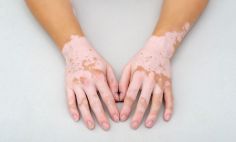Vitiligo is a skin condition affecting roughly one in 100 people in the U.S. It causes areas of skin to lose pigmentation (color), resulting in light or white patches.
The condition is an autoimmune disease, causing the body's immune system to attack and destroy its own tissue cells. In this case, it attacks skin cells that give the skin pigment.
Where it happens
Vitiligo can happen more frequently on your face and hands, and at pressure points such as your knees and elbows. Vitiligo is a progressive disease that may evolve either slowly or rapidly. While some people develop only a few patches of white skin, others can get patches that cover most of their body.
Two types of vitiligo
- Vitiligo is when white patches appear symmetrically on both sides of the body. It is the most common type, accounting for up to 90% of cases.
- Segmental vitiligo is much less common. It happens when white patches appear in a localized area on only one side of the body. While it is less responsive to topical treatments like creams, segmental vitiligo generally develops for a short period of time only and then stops, so it is a good candidate for surgical treatments like skin grafts.
Who it affects
Vitiligo is more noticeable in those with darker skin tones, but it can affect people of any race or age.
Treatment options
Researchers supported by the National Institutes of Health are close to getting approval for a new, targeted vitiligo treatment using Janus kinase (JAK) inhibitors. For now, other treatment options include the following:
- Phototherapy, also called light therapy, carefully exposes your skin to limited amounts of ultraviolet light. It is recommended for large areas affected by vitiligo.
- Laser treatment is recommended for smaller areas of vitiligo, especially those on the face.
- Steroid creams and ointments applied to the skin help suppress the immune system.
- Surgical techniques include skin grafting, which places pigmented skin from a donor on areas of vitiligo.
- Depigmentation, or bleaching, is a permanent change and is used mostly when the full body is affected.
Not every treatment is right for everyone, and many have side effects. But work to discover more broadly effective, longer lasting treatments offers hope.
Finding help
For those with vitiligo, the emotional impact of the condition can be as intense as the physical effects. The condition is not contagious or life-threatening, but it can cause low self-esteem.
People with vitiligo can become depressed and withdraw from friends and family. It's important for those with the condition to find support from friends or loved ones, counselors, or support groups.







